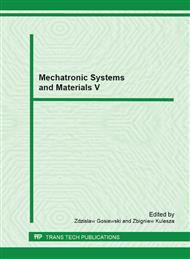p.170
p.176
p.182
p.188
p.194
p.200
p.205
p.209
p.217
The Influence of Workpiece Hardness on Plate Temperature during One Side Lapping
Abstract:
Lapping leads to a surface with low roughness and high precision. Because of required parts accuracy tool flatness is the key to the successful machining. To avoid its excessive thermal expansion, plate temperature research was taken. The goal was to determine the correlation between the basic lapping conditions and wheel temperature. In work [1] authors developed model to estimate the maximum and average temperature rise of the work surface in lapping. According those models temperature rise depends also on workpiece and plate hardness. Because the second is constant during process, this part of research refer only to the influence of workpieces hardness. They were conducted during lapping the samples made of steel 45. To vary the hardness, samples were divide into three groups each with different Knoop hardness value: 175, 471 and 687. The different hardness values were a result of different heat treatment methods used. Every group after grinding were lapped with the same lapping conditions. In the next step the statistical analysis was conducted. It was verified if the plate temperature is influenced by the workpieces hardness. A hypotheses testing method was use. Results were calculated for temperature rise values measured after 300 minutes of machine working. According to them the influence of workpiece hardness on plate temperature is statistically insignificant.
Info:
Periodical:
Pages:
194-199
Citation:
Online since:
March 2013
Authors:
Keywords:
Price:
Сopyright:
© 2013 Trans Tech Publications Ltd. All Rights Reserved
Share:
Citation:


